"Wilkes was a good friend and faithful brother, and popular with all who knew him. Too popular, some said: too much of the convivial dram drinker, too much the pursuer of pretty ladies..." (Chicago Tribune)
Abraham Lincoln attended the play Our American Cousin at Ford's Theatre that night. He sat in a red velvet rocker, his wife Mary Todd Lincoln beside him. All of a sudden, an assassin appeared from behind the curtain, pulled out a revolver, and shot the president; he leaped over the side of the balcony, fracturing his leg, and exited the theatre, leaving Lincoln for dead.
John Wilkes Booth was a young fanatic. "Most of his friends were Southern and all of his beliefs..." (http://archives.chicagotribune.com/1940/01/28/page/93/article/the-man-who-killed-lincoln-called-bad-showmanship). He was disturbed to hear that President Lincoln called for the vote for the "freed Negro" only days after the Civil War ended. He plotted to kill him, along with Vice President Johnson, General Grant and General Seward. He thought General Lee would then withdraw his surrender, reassemble his army and save the Confederate's cause.
But his fractured leg got in the way. A doctor named Mudd treated Booth that day for his injury. When the public found out, they were unamused. Hence, the saying when you are in trouble: "Your name will be Mudd". Booth escaped to Confederate territory where he took his final stand in a tobacco shed. He was holding his revolver to his head when he was shot by a sentry and killed.
Lincoln passed away the following morning. He was given a hero's farewell, complete with a caisson, a 21-gun salute, and a funeral train which crossed the United States from Washington D.C. to his home state of Illinois (en.wikipedia.org/wiki/Funeral_and_burial_of_Abraham_Lincoln). No American would ever forget how he held the country together through the Civil War, how he took a stand on slavery, no matter how unpopular he would appear.
On January 17, 1940, seventy five years after the assassination, The Man Who Killed Lincoln premiered at the Longacre Theatre on Broadway. Charles Keane starred as Lincoln, Mary Dorne as Mrs. Lincoln, and Richard Waring as John Wilkes Booth. According to the Chicago Tribune, however, it was Whitford Kane, as Samuel Fox, who stole the show.
A century and a half later, Lincoln is still remembered fondly. Millions visit Gettysburg National Park each year where the president delivered his infamous Gettysburg Address. And the red velvet chair that Lincoln sat in at Ford's theatre sits in the Henry Ford Museum in Dearborn, Michigan. John Wilkes Booth is buried in a small grave in Baltimore, Maryland.

commons.wikimedia.org/wiki/File:Fords_Theater_Scene_in_the_Abraham_Lincoln_Museum.jpg
No comments:
Post a Comment